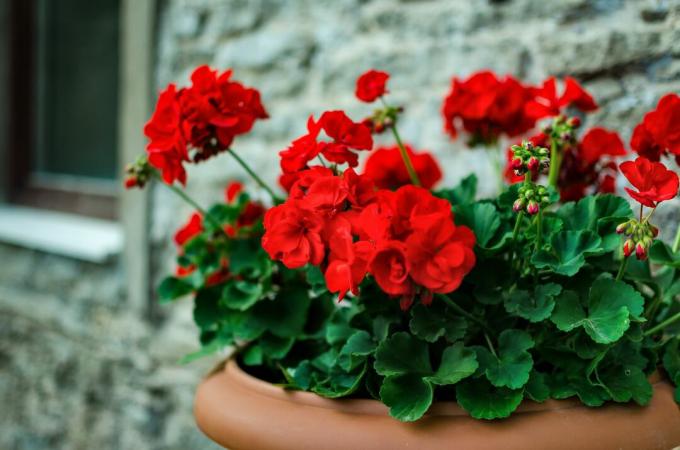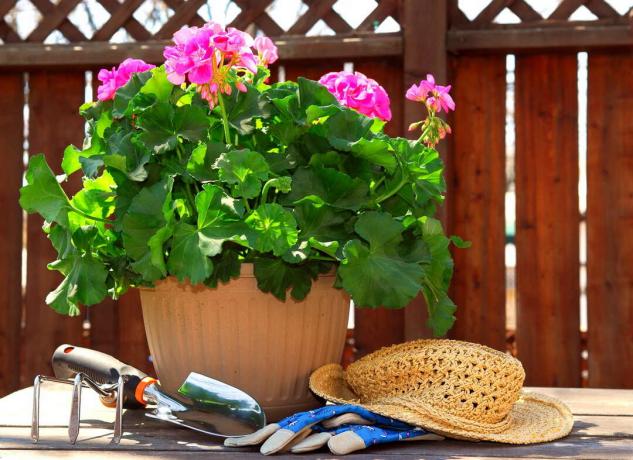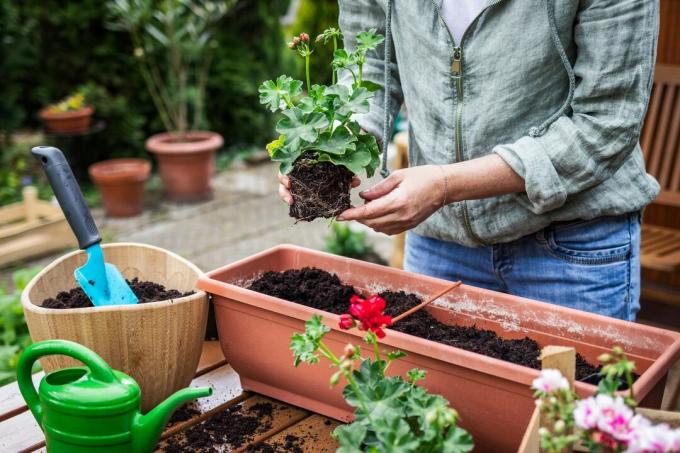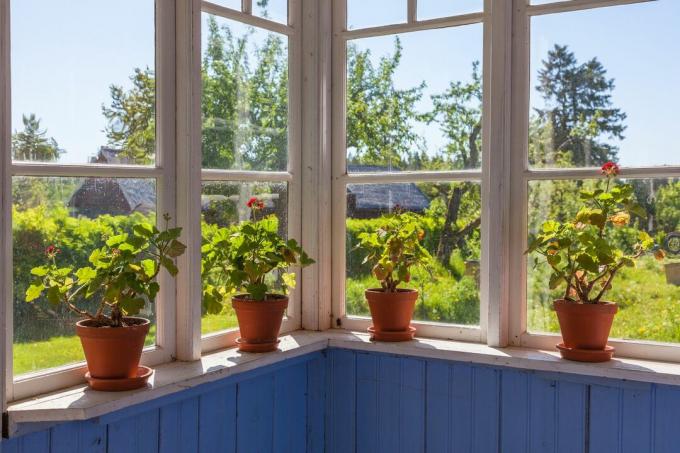Here you can find out everything about planting standing and hanging geraniums, the optimal location and the right accompanying plants.

Geraniums or PelargoniumAs the plant is called with its botanical name, they are a real feast for the eyes with their sea of flowers on the balcony at home. This genus includes around 250 different wild species. Most of the species originally come from sunny South Africa. The perennial plants that are not hardy grow as subshrubs or shrubs at different heights. Intensive breeding has resulted in a large number of cultivars that not only impress with flowers in a wide variety of colors, but also differ in their growth forms. The most important of these types of pelargonium are nowadays P. zonal Hybrid and P. peltatum Hybrid.
contents
-
Geraniums Growth forms: Standing and hanging geraniums
- Standing geraniums
- Hanging geraniums
- Scented geraniums - possible uses for geraniol
- Geraniums: the ideal location
- The right geranium soil
-
Planting geraniums: in pots, tubs and traffic lights
- Planters for geraniums
- Geraniums planting time and repotting
- Geraniums as house plants
- Geranium companion plants
Geraniums Growth forms: Standing and hanging geraniums
The way the geraniums grow affects the choice of the right location and planter. With the right choice, you will support herbal well-being and put your geraniums in the limelight. A general distinction is made between hanging geraniums (Pelargonium peltatum Hybrid) and upright geraniums (Pelargonium zonale Hybrid).
Standing geraniums
Upright geraniums are evergreen subshrubs and reach heights of 25 to 40 centimeters. They are unbeaten among the geraniums in terms of their variety. This group is ideally suited for balcony boxes and pots as well as planted in the bed. The noble geraniums (Pelargonium grandiflorum) also called English geraniums. They have numerous, impressive flowers, but they must be protected from rain.

Hanging geraniums
Geraniums with a pendulous growth habit are usually up to 30 centimeters high and can form overhanging shoots over 150 cm long. These shoots make hanging geraniums a long-runner in balcony boxes, hanging baskets or in vertical gardens on the balcony. Robust, single-flowering varieties such as the ‘Cascade’ series or the well-known pink ‘Ville de Paris’ are particularly popular.

Scented geraniums - possible uses for geraniol
The fragrant geraniums form a special group of geraniums. When it comes to scented geraniums, it is not the eye that chooses, but the nose. Countless variations surprise with special flavors, such as ‘Chocolate Peppermint’ (chocolate) or ‘Purple Unique’ (wine gum). Here the ornamental value counts less than the possible uses of your leaf extract.

The geranium oil (geraniol) of certain types is used in perfumes, cosmetics, aromatherapy and has a relaxing effect on the muscles. Some scented geraniums are said to even deter mosquitoes with the help of their spicy aroma. The plants are therefore not only beautiful to look at, but can even score with practical added value.
Geraniums: the ideal location
As their African roots suggest, pelargoniums are heat-resistant plants and true friends of the sun. They prefer a warm and full sun to partially shaded location. With noble geraniums, however, the following applies: If possible, without full sun. A light breeze does not harm the plants, but the shoots can break easily in stronger winds. With hanging geraniums there is a quick risk of the flowers sticking together when it rains continuously, so you should choose a covered location. In order for geraniums to bloom continuously until frost, they need cooler nights. To ensure that the number of flowers is correct, the following applies: the more hours of sunshine, the more flowers are formed.

Summary: The optimal location for geraniums
- warm and full sun to partially shaded location
- protect from strong winds
- Hanging geraniums: covered location
The right geranium soil
Nutrient-rich compost or high-quality, structurally stable plant soil is used to cultivate pelargoniums. Special geranium soil can be used so that your geraniums feel good thanks to an optimal supply of nutrients. This is particularly nitrogen-focused.
Planting geraniums: in pots, tubs and traffic lights
Planters for geraniums
Geraniums are usually planted in pots, hanging baskets and window boxes. Standing geranium varieties can also be planted directly in the bed. A large volume of soil is important for the development of geraniums. Large pots or large window boxes (20 x 100 centimeters) are particularly suitable. Up to five copies can be used here. The box should be at least 18 centimeters high so that an optimal fertilizer and water supply can be provided later. Planters for geraniums should have a water drainage hole or good drainage e.g. B. Have expanded clay, because sun worshipers don't like wet feet at all.

Hanging varieties should be planted in higher pots or boxes so that they can develop according to their growth characteristics. To make it easier for the hanging balcony plant to establish itself, it is an advantage to plant the plants slightly “at an angle” in the box. However, the root balls must still have good substrate contact.
Summary: Requirements for the geranium planter
- large pot or balcony box (20 x 100 cm) for ~ 5 plants
- Height min. 18 cm
- Water drainage holes or good drainage (e.g. B. Expanded clay) to avoid waterlogging
- Plant hanging geraniums at an angle
Geraniums planting time and repotting
The plants are usually well rooted when bought in culture pots. For a lush growth and a rich abundance of flowers, these therefore urgently need to be transplanted. It is important to open the root ring on the ball when planting. This makes it easier for the plants to take root in the fresh soil. Young geraniums are potted in larger planters when numerous roots emerge from the drainage hole and these begin to clog.

Older plants can be repotted in fresh soil about every 2 years. In doing so, you carefully shake the old soil out of the roots and shorten the long, thicker roots and also the shoots of the plant by about half. Then you put the pelargoniums prepared in this way back into the old, well-cleaned pot with fresh soil. You can use the cut shoots as cuttings Propagation of your geraniums to use. You can find out how to do this here.
The best time to repot is spring. In general, however, the pelargoniums can also be repotted during the rest of the year.
From the end of February, the plants, which have been repotted in fresh soil, can grow in a bright, cool window seat. In cold regions, geraniums are only planted in good balcony flower or geranium soil from mid-May. Do not put noble geraniums outdoors until warm days are guaranteed.

Summary: planting time and repotting geraniums
- Repot geraniums after purchase
- young geraniums: repot when the planter is completely rooted
- older geraniums: repot every 2 years
- best time to repot: spring, but generally possible all year round
- Plant outside from mid-May
Geraniums as house plants
Geraniums feel at home in the heated room. If the plants are properly cared for, you can enjoy their numerous flowers almost all year round in a large pot on the sunny windowsill. What needs to be done to ensure that the Care of the geraniums right and the plants feel good all year round, we have put together for you here.

Geranium companion plants
The balcony classic can be combined alone and with almost all sun-loving balcony flowers. It is only important that the vigor and the water requirements match those of the partners in the box or planter. Examples of combinations are: petunias, magic bells, bidens, verbenas, magic snow, Vanilla flower, Lantane, Hussar's Head, Blue Daisy, Loyal to Men, Purslane.
In order for your planted geraniums to bloom beautifully, a few care measures are required. Here you can find out everything about the topic Caring for geraniums.



